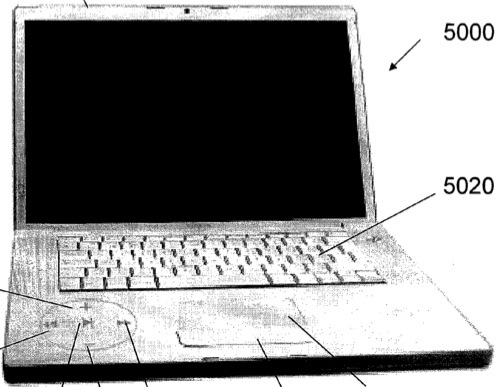Apple — or at least CEO Steve Jobs — probably won’t be happy until we can control our Macs, iPhones, iPods and iPads complete by brain waves. A new patent (20200103116) is for a disappearing button or slider and shows Apple’s continued war to eliminate buttons on its devices.
An input device is disclosed. The input is a deflection based capacitive sensing input. Deflection of a metal fame of the input device causes a change in capacitance that is used to control a function of an electrical device. The input appears invisible because it is made of the same material as the housing it is contained in. Invisible backlit holes may make the input selectively visible or invisible to the user. The inventors are Omar S. Leung and David T. Amm.
Here’s Apple’s summary and background of the invention: “The present invention relates generally to input devices and device display systems, and more particularly to invisible input systems and device display systems. The input devices and display systems may become visible when illuminated from behind through invisible holes.
“In the world of consumer devices, and particularly consumer electronics, there is an ever-present demand for improved appearance, improved functionality, and improved aesthetics. Industrial design has become a highly skilled profession that focuses on fulfilling this need for enhanced consumer product appearance, functionality, and aesthetics.
“One area that receives attention for improvement, particularly in consumer electronics, is user input and interface. Presently there exists a range of mechanically actuated (e.g., buttons, switches, levers, keys, keyboards, dials, click wheels, scroll wheels, and the like) or electrically actuated (e.g., touch pads, track pads, touch screens, multi-touch screens, and the like) input devices. These input devices interface with their associated electronic devices (e.g., computers, laptop computers, media devices, mobile phones, calculators, medical devices, etc. . . . ) in order to control a function of the device, for example, turn the device on or off, open a menu, move a cursor and so forth.
“One challenge with these known input devices is that they may detract from the aesthetics of the device by interrupting the continuity of the device housing. To illustrate, compare a mobile phone having a traditional key pad with the iPhone produced by Apple Inc. of Cupertino, Calif. The iPhone has a flat touch-sensitive screen which presents a striking, seamless design, while the traditional mobile phone presents a cluttered array of keys and buttons. Besides the obvious aesthetic advantages of having a seamless design, a seamless design may have improved functionality and/or durability. For example, a traditional mechanical key pad can wear out over time and/or be ruined by dirt or moisture entering into the openings in the device housing. These openings are necessary to accommodate the traditional keys and buttons.
“The iPhone touch screen uses capacitive sensing. This type of sensing takes advantage of the fact that two electrical fields separated by a dielectric produce capacitance. In the iPhone, a first electrical field is produced inside the iPhone by an array of electrodes. The second electrical field is provided by the user’s finger. When the finger interacts with the glass touch surface a circuit inside the iPhone detects a change in capacitance and processes this change in order to compute, for example, the location and speed of the scrolling finger. Some modern track pads on laptop computers may function in a similar way, but normally have plastic or rubber track surfaces. In all of these devices the housing of the device is normally metal, while the track surface is normally a dielectric material such as rubber, plastic, or glass. Therefore, a truly seamless design has been impossible. Furthermore, a glass surface may be fragile.
“Taken to its extreme, seamless design would have an invisible input. Since a metal housing is advantageous for aesthetic, environmental, and manufacturing reasons, this presents a particular challenge. One method to overcome this challenge is to include a plastic input painted to look like metal. However, this will not match the metal look and finish exactly, so the truly seamless design is not realized.
“Another area that continually receives great attention for improvement is user displays. Providing crisp, attractive, unambiguous, and intuitively friendly displays and information for the user is very important in many consumer products. However, as consumer products constantly become smaller and smaller, and in some cases more and more complex, it becomes increasingly difficult to present and display user information in a manner that is easy for the user to grasp and understand, but is also in an uncluttered form and appearance that is aesthetically pleasing.
“Much of the aesthetic appeal of a consumer product can quickly be compromised if there are too many display elements, or if too much display area is occupied by display elements that are not needed except at particular times. When not needed, these ???passive??? or unactivated display elements invariably remain visible to the user, even though they are in the ???off??? state. This is not only displeasing from an aesthetic standpoint, but it can be an annoying distraction that interferes with detection and understanding of other display elements that need to be observed at a given moment.
“Illuminating display elements is known. Some display elements are illuminated continuously; others are illuminated only when appropriate to instruct and guide the user. Display elements that are not continuously illuminated can still be distracting, or at least aesthetically objectionable, when not illuminated (when in the off state) because they may still remain visible in the display area.
“For example, one typical such display element is configured from transparent plastic inserts that penetrate through the metallic case of an electronic device, and are smoothly flush with the outer surface of the case. A large number of such always-visible display elements leads to a cluttered, confusing, and unattractive appearance. In fact, even a single such element, when not illuminated (i.e., in an inactive state), can become an unattractive distraction on an otherwise smooth and attractive surface.
“Less expensive device housings, for example, those made of opaque plastic rather than metal, are often similarly provided with transparent plastic inserts for illuminated display elements. These display elements also conflict with a good aesthetic appearance when they are not illuminated. Also, displays using plastic or glass are less durable than metal and are more subject to breaking or cracking.
“Additionally, the separate visible inserts utilized by prior techniques sometimes do not fit perfectly in the holes in which they are inserted or formed. Such imperfect fit can invite entry of liquids, dirt, and the like, undesirably causing yet another disadvantage.
“Thus, the need exists for commercially feasible device display systems with improved aesthetics that unobtrusively furnish information as appropriate, but otherwise do not distract or detract from the user’s experience or the device’s performance. Preferably, selected elements of such display systems would additionally become invisible in their off states.
“In view of ever-increasing commercial competitive pressures, increasing consumer expectations, and diminishing opportunities for meaningful product differentiation in the marketplace, it is increasingly critical that answers be found to these challenges. Moreover, the ever-increasing need to save costs, improve efficiencies, improve performance, and meet such competitive pressures adds even greater urgency to the critical necessity that answers be found.
“The invention relates in one embodiment an electronic device having an invisible input. The device has a frame having a top face with invisible holes formed therein. A capacitor reference is on an inner surface of the top face in the area of the invisible holes. An interior wall is separated from the top face and forms an interior space having a dielectric medium disposed therein. A capacitor plate is disposed on a surface of the interior wall opposite the first capacitor plate. A light source is disposed in the interior space and is configured to shine through the invisible holes. A capacitor sensor is electrically connected to the capacitive reference and the capacitor plate. When an object is placed on the frame in the area of the invisible holes and pressure is applied, the frame deforms. This deformation causes a change in capacitance between the capacitive reference and the capacitor plate. The capacitor sensor detects this change and converts it to an electrical signal.
“The invention relates in another embodiment to an invisible input. The invisible input has a frame having a top face with invisible holes formed therein. A capacitor reference is on an inner surface of the top face in the area of the invisible holes. An interior wall is separated from the top face and forms an interior space having a dielectric medium disposed therein. A capacitor plate is disposed on a surface of the interior wall opposite the first capacitor plate. A light source is disposed in the interior space and is configured to shine through the invisible holes. A capacitor sensor is electrically connected to the capacitive reference and the capacitor plate. When an object is placed on the frame in the area of the invisible holes and pressure is applied, the frame deforms. This deformation causes a change in capacitance between the capacitive reference and the capacitor plate. The capacitor sensor detects this change and converts it to an electrical signal.”



